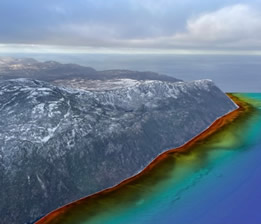EES Departmental Seminar: Maureen Matthew, Graduate Student Symposium
Maureen Matthew
Ph.D. Candidate
Department of Earth and Environmental Sciences
Dalhousie University
Title: A Land to Sea Perspective on Coastal Geohazards in High-Latitude Fjords

 Abstract: In high-latitude glacierized fjords, where climate warming is driving deglaciation and permafrost thaw, the frequency and magnitude of mass movements is expected to increase, which poses a risk to public safety and drives a need for better characterization of geohazards in these regions. Key among these are rock avalanches, glacial lake outburst floods, submarine landslides, and turbidity currents, all of which can impact marine infrastructure and, in some cases, lead to displacement waves. Here I leverage the marine and terrestrial records to investigate these processes in NE Canadian fjords in the context of climate change.
Abstract: In high-latitude glacierized fjords, where climate warming is driving deglaciation and permafrost thaw, the frequency and magnitude of mass movements is expected to increase, which poses a risk to public safety and drives a need for better characterization of geohazards in these regions. Key among these are rock avalanches, glacial lake outburst floods, submarine landslides, and turbidity currents, all of which can impact marine infrastructure and, in some cases, lead to displacement waves. Here I leverage the marine and terrestrial records to investigate these processes in NE Canadian fjords in the context of climate change.
Project 1 provides an inventory of rock avalanche deposits in coastal NE Baffin Island, between the hamlets of Clyde River and Pond Inlet. The total number of mapped deposits in this region falls far below documented inventories from analogous high-latitude fjords of Greenland, Norway, and Alaska. The results of this project motivated a conceptual time-transgressive deglacial slope instability model and a hypothesis that Baffin Island fjords are in a temporary period of quasi-stability, which follows initial deglaciation and precedes climate-induced destabilization.
Project 2 focuses on an active fjord head environment in Gibbs Fjord, NE Baffin Island to study coastal sediment transport and geohazard evolution during deglaciation. By combining an analysis of the marine sediment record with terrestrial mapping, I show that deglaciation in the fjord watershed controlled the frequency and timing of turbidity currents in the delta. The identification of potential late Holocene glacial lake outburst floods in the fjord sediments suggests that deglaciation shifted the dominant type of marine geohazards in the fjord head due to the formation of large proglacial lakes east of Barnes Ice Cap.
Project 3 examines a massive coastal deep-seated gravity deformation in NW Newfoundland with an objective to characterize its complex structure and to establish its timing and rate of deformation. I will test a hypothesis that this ‘sackung’ formed in response to glacial debuttressing and investigate the potential for contemporary residual displacement. This analysis will provide insight on large-scale coastal instabilities millennia after complete deglaciation and permafrost degradation.
Biography: Maureen is a professional engineering geologist with fifteen years of experience in applied geosciences, geotechnical engineering, and resource development. She graduated with a BSc. (Honours) from Dalhousie University in 2005, followed by an MSc. in Geological Engineering from Queen’s University in 2008. Her career in engineering geology began in 2008 at the internationally recognized Norwegian Geotechnical Institute in Oslo, Norway where her research focused on laser scanning and geohazard analysis. Since 2009, she worked at Stantec Consulting to build their applied geoscience services within the geotechnical practice across Canada. At Stantec, she was team lead for the geotechnical group in and an experienced project manager before taking academic leave to pursue a PhD. She is currently a PhD candidate in the CRISDal Lab focusing her research on coastal geohazards in NE Canadian fjords.
Time
Location
Format: In person.
Milligan Room, 8th Floor Biology-Earth Sciences Wing, Life Sciences Centre, Dalhousie University
